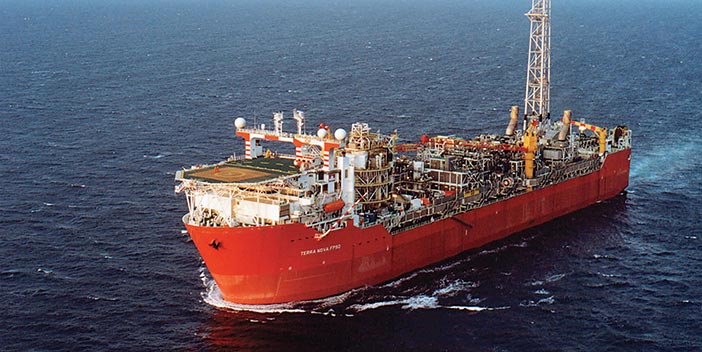
Find your Country and language
Lubricants Beyond Today's Standards TM
Petro-Canada™ Lubricants' distribution network extends to over 80 countries worldwide
This website uses cookies. By continuing to browse this website you are agreeing to our use of cookies. Find out more by reading our privacy policy.
Excluding the regions of Crimea, Donetsk and Luhansk

Petro-Canada™ Lubricants' distribution network extends to over 80 countries worldwide
About Terra Nova
The Terra Nova FPSO, producing in the North Atlantic 350 kilometres southeast of Newfoundland and Labrador, Canada, is one of the largest FPSO vessels ever built, at a length of 292.2 metres, a width of 45.5 metres and it stands more than 18 storeys high. The FPSO can store 960,000 barrels of oil and accommodate up to 120 personnel while producing. Terra Nova is a joint venture owned by seven oil companies, including Suncor Energy (the Operator), with a 37.6% working interest..


Colin Haley,
P. Eng. Mechanical Engineer,
Terra Nova FPSO
(PDF, 395 KB)
The Terra Nova FPSO vessel offered attractive capabilities for its owners over the expected 15-17 year life of the Terra Nova reservoir. But there are challenges associated with FPSOs. The conditions are harsh for the operating equipment. On-board turbines are expected to run essentially non-stop in high seas. Heavy wave action can make every maintenance task that much more difficult.
Percy Delaney is a Mechanical Maintenance Engineer with the Terra Nova consortium. He points out that “the Terra Nova FPSO is designed to remain on location for years at a time. It is also designed to withstand severe storms, known as 100 year storms.” As Delaney explains, “On one occasion we observed 14 metre waves washing over the main deck.” Typical conditions are harsh, compounded by extreme cold, high winds and fog as well as seasonal ice and icebergs.”
Among the components that made up the Terra Nova FPSO were a pair of Thomassen/General Electric PG6561B Frame 6B Heavy Duty Gas Turbines that are used for power generation. These turbines employ a geared speed reduction system. In this type of application, the lubricant has to do double duty, lubricating both the turbine bearings and gears. Consequently, this is a challenge for any lubricant because the requirements for gear lubrication are different than those of the turbine shaft bearings. According to Delaney, use of large frame turbines off shore is uncommon. Compared to the more prevalent aero-derivative turbines, frame units enjoy extended operating life but they need to be repaired on-site. The combination of confined, hazardous spaces and sea-state limits on the maintenance cranes makes repairs challenging, so reliability is critical.
Nick Finelli, a Technical Service Advisor with Petro-Canada recollects the first contact with the turbine manufacturer’s representative. “He was pretty cautious. We had no history with Thomassen. These turbines aren’t sitting on a plant floor. On the ocean, a turbine failure can be catastrophic.” Tech Services was looking for an EP turbine product. Petro-Canada Research & Development had been a couple of years in development with Turboflo™ EP 32 at the time. We knew that Thomassen had some concerns about “EP” turbine fluids. The industry had seen problems with varnishing in a similar application in the North Sea. The lube oil coolers had developed a buildup of varnish after only 18 months, while using a competitor product. This led to excessively high lubricant temperatures and an eventual 25% decrease in power before a shutdown was necessary to clean the coolers.
In order to convince Thomassen, Petro-Canada relied on its core strengths, an intensive data monitoring process combined with a highly collaborative customer relationship. Field tests provide the best validation. The initial fill was done in April of 2000 and the commissioning phase ended in January of 2002.
Petro-Canada’s TURBOFLO EP formulation is ideal for modern heavy-duty gas turbines. Over the course of commissioning, the equipment received monthly lubricant analyses. Physical and chemical properties including viscosity, additive level and oxidative stability remained constant throughout this period of time. Developing a product like Turboflo EP requires a company to listen carefully to the requirements of both its customers and the industry and be committed for the long haul.
Petro-Canada’s Turboflo EP exhibits properties such as excellent oxidation and thermal stability, antiwear protection, corrosion inhibition as well as exceptional water and air separation.
Reliability is the hallmark of Petro-Canada lubricants, such as Turboflo EP, and it is a quality much appreciated by customers such as the Terra Nova consortium. Percy Delaney notes that “these turbines are 40 megawatt units. If we lose one, our output drops by 20,000 barrels a day. That’s why we require 97% availability of the turbines. A reliable power supply directly affects our bottom line.”
“We’re pleased with the results,” declares Delaney. “In September (2005) we changed out the initial fill. We had a scheduled shutdown that presented a perfect opportunity. That was after about 28,000 fired hours of operation. I think you could say we got our use out of it.” As an additional aside he mentions that the Thomassen maintenance personnel were favourably impressed by the troublefree performance of the fluid. The Terra Nova project stands as a testament to the Petro-Canada product development philosophy. By staying abreast of industry trends and being responsive to the needs of customers, the company continues to see change as an opportunity.
“These are demanding conditions. Terra Nova has to maintain production in the heavy Atlantic seas, with a lot of wave action. TURBOFLO EP has provided 15 years of service, no hiccups. Terra Nova’s turbines have been running for approximately 97,000 hours and counting. TURBOFLO EP has given Terra Nova multiple years of stable and reliable operation in a harsh marine environment under all operating conditions.” Colin Haley, P. Eng. Mechanical Engineer, Terra Nova FPSO (2016)


Jamie Enright,
Owner/Operator,
M.J. Enright and Sons Logging, Inc.

Craig Price,
Vice President,
Operations, Morbark

Tim Briggs,
Mill Manager,
J. W. Jones Lumber Company, Inc.